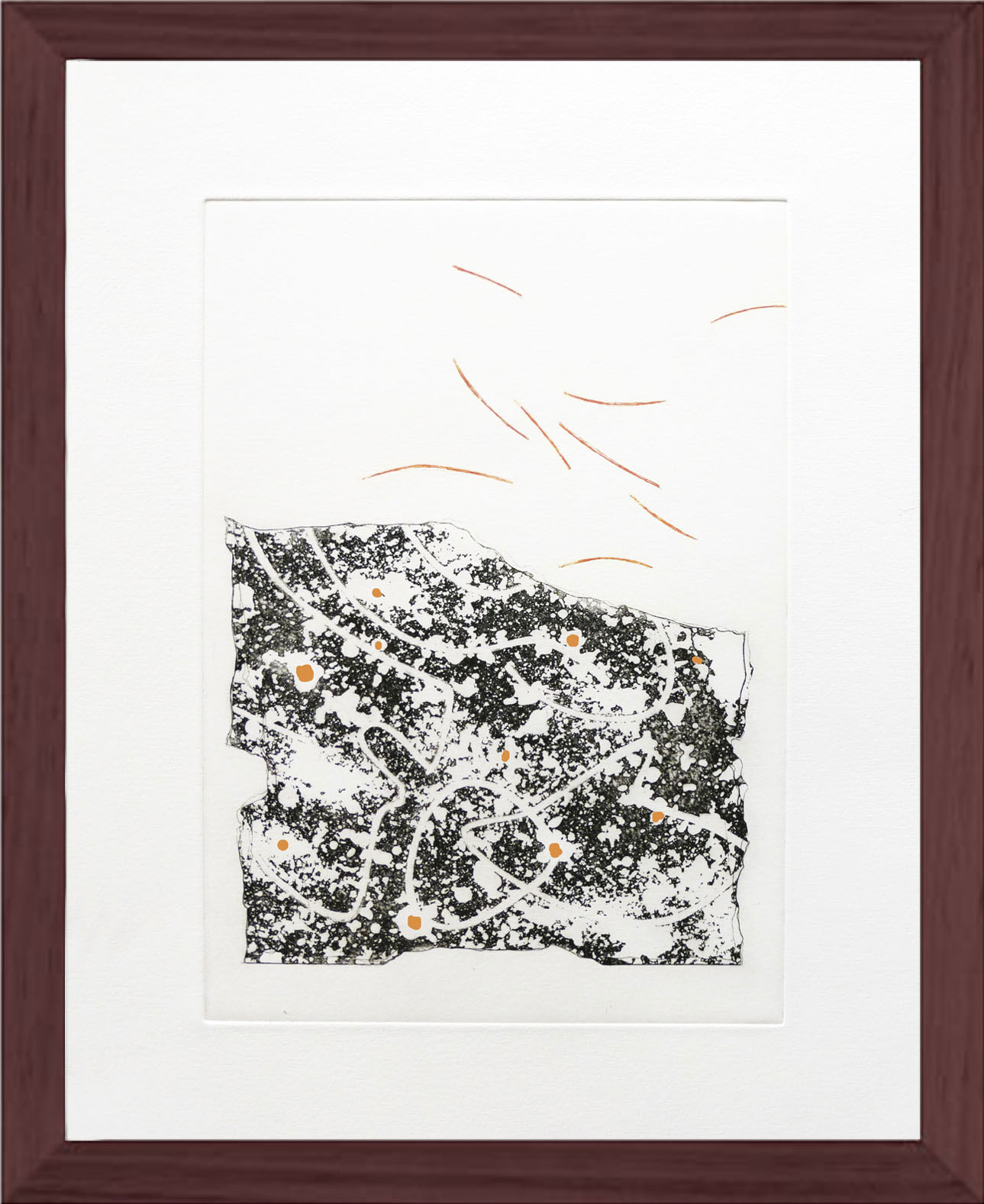Etchings
Judy Walsh makes etchings using both techniques described below. Some etchings have been printed in two or more colours, either by using a separate plate for each colour or applying more than one colour to a plate. in addition, colour can be applied after the print has dried either using watercolour or another medium (see no. 3. Fireflies below)
Etching is a printmaking technique that uses chemical action to produce incised lines in a metal printing plate which then hold the applied ink and form the image.
The plate, traditionally copper but now usually zinc, is prepared with an acid-resistant ground. Lines are drawn through the ground, exposing the metal.
The plate is then immersed in acid and the exposed metal is‘bitten’, producing incised lines. Stronger acid and longer exposure produce more deeply bitten lines. The resist is removed and ink applied to the sunken lines, but wiped from the surface.
The plate is then placed against paper and passed through a printing press with great pressure to transfer the ink from the recessed lines. Sometimes ink may be left on the plate surface to provide a background tone.
Like engraving, etching is an intaglio technique.
Intaglio refers to all printing and printmaking techniques that involve making indents or incisions into a plate or print surface which hold the ink when ink is applied to the surface and then wiped clean.
Aquatint is a printmaking technique that produces tonal effects by using acid to eat into the printing plate creating sunken areas which hold the ink.
Like etching, aquatint is an intaglio printmaking technique but is used to create tonal effects rather than lines. Intaglio refers to printing and printmaking techniques in which the image is incised into a surface, and the incised line or sunken area holds the ink.
Fine particles of acid-resistant material, such as powdered rosin, are attached to a printing plate by heating. The plate is then immersed in an acid bath, just like etching. The acid eats into the metal around the particles to produce a granular pattern of tiny indented rings. These hold sufficient ink to give the effect of an area of wash when inked and printed. The extent of the printed areas can be controlled by varnishing those parts of the plate to appear white in the final design. Gradations of tone can be achieved by varying the length of time in the acid bath; longer periods produce more deeply-bitten rings, which print darker areas of tone.
The technique was developed in France in the 1760s, and became popular in Britain in the late eighteenth and early nineteenth centuries.
It is often used in combination with other intaglio techniques.
Ref: Tate Gallery London
Please scroll down to see all the prints on this page.

Under the wave
A contemporary version of the famous print by Katsushika Hokusai, Under the Wave off Kanagawa.
Etching Paper size: 28.05cm x 39cm Print size: 15cm x 20cm Paper: Hahnemûhle 300gsm Edition: 15 (See Judy Walsh's video of the same name.)

Katsushika Hokusai: Under the Wave off Kanagawa.

2. Fissure
A crack or split.
Etching. Limited edition print
Paper size: 27cm x 39cm
Print size: 15cm x 20cm
Paper: Hahnemühle 300gsm
Edition: 10

3. Fireflies.
How beautiful but short lived they are.
Etching & watercolour. Limited edition print
Paper size: 53.5cm x 79cm
Print size: 45.05cm x 62cm
Paper: Hahnemühle 300gsm
Edition: 3
See Judy Walsh's painting of the same name.

4. Fireflies
How beautiful but short lived they are.
Etching. Limited edition print
Paper size: 27cm x 39.05
Print size: 15cm x 20cm
Paper: Hahnemühle 300gsm
Edition: 10
See Judy Walsh's painting of the same name.

Dolmen
Many Dolmens are oriented towards the direction of the rising sun on the solstices. Many also have an opening in one end that lets in the ray of light from the sun on the Winter and Summer solstice.
Etching. Limited edition print
Paper size: 31cm x 27cm
Print size: 15cm x 20cm
Paper: Hahnemühle 300gsm
Edition: 20
See Judy Walsh's painting of the same name.

7. Floating World
Derived from the Buddhist metaphor for the impermanence of life and the world of fleeting pleasures. What originally signified a sadness of the impermanence of our own short and troublesome lives (captured in the homonym 'ukiyo' meaning sorrowfull world) changed and became seeking momentary pleasure in the delights of the material world.
Etching. Limited edition print
Paper size: 39cm x 57cm
Print size: 15cm x 20cm
Paper: Hahnemühle 300gsm
Edition: 10
See Judy Walsh's painting and drawings of the same name.

8. String Theory
Strings are elementary particles that are joined together. Because the strings have tension, they vibrate. There are two basic types of string: Strings as in a closed loop which can break apart into a vibrating open string, and strings that are closed loops, and which cannot break apart.
Etching. Limited edition print
Paper size: 39cm x 53cm
Print size: 15cm x 20cm
Paper: Hahnemühle 300gsm
Edition: 10

Caverne
The oldest figurative paintings are those made in prehistoric times.
Etching
Paper size: 21cm x 29.7 Print size: 14.5cm x 20cm Paper: Hahnemûhle 300gsm Edition 10

9. Nellie
Portrait.
Etching. Limited edition print
Paper size: 39cm x 53cm
Print size: 15cm x 20cm
Paper: Hahnemühle 300gsm
Edition: 10

Contre-jour
Monotype ( a print that is unique) in yellow and black. See painting of the same name for further information.
